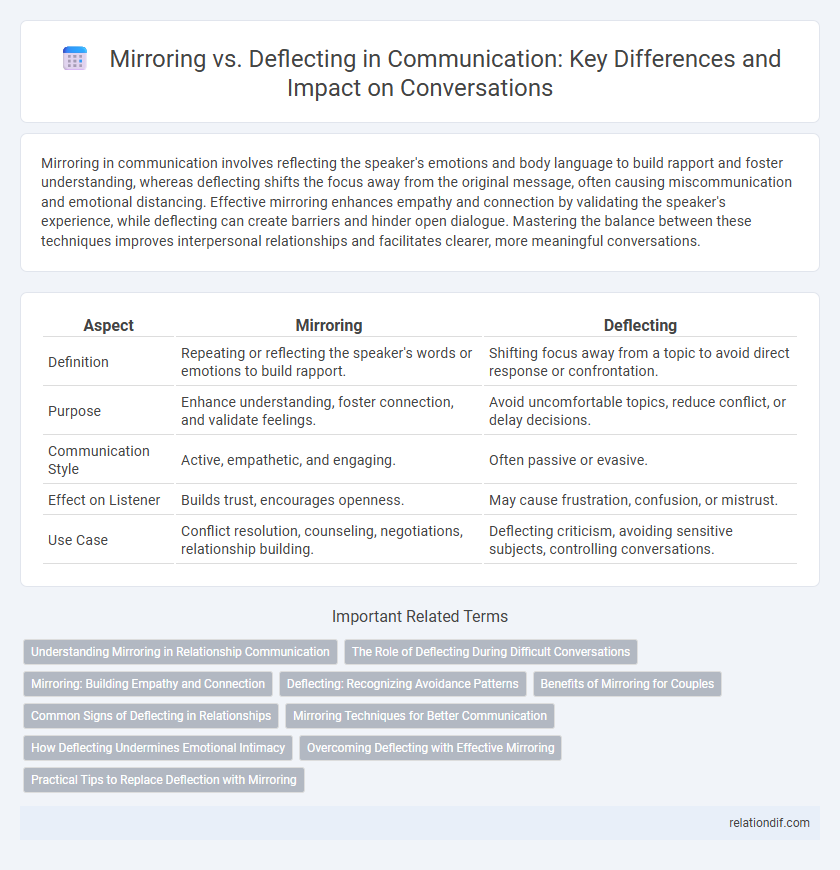Mirroring in communication involves reflecting the speaker's emotions and body language to build rapport and foster understanding, whereas deflecting shifts the focus away from the original message, often causing miscommunication and emotional distancing. Effective mirroring enhances empathy and connection by validating the speaker's experience, while deflecting can create barriers and hinder open dialogue. Mastering the balance between these techniques improves interpersonal relationships and facilitates clearer, more meaningful conversations.
Table of Comparison
| Aspect | Mirroring | Deflecting |
|---|---|---|
| Definition | Repeating or reflecting the speaker's words or emotions to build rapport. | Shifting focus away from a topic to avoid direct response or confrontation. |
| Purpose | Enhance understanding, foster connection, and validate feelings. | Avoid uncomfortable topics, reduce conflict, or delay decisions. |
| Communication Style | Active, empathetic, and engaging. | Often passive or evasive. |
| Effect on Listener | Builds trust, encourages openness. | May cause frustration, confusion, or mistrust. |
| Use Case | Conflict resolution, counseling, negotiations, relationship building. | Deflecting criticism, avoiding sensitive subjects, controlling conversations. |
Understanding Mirroring in Relationship Communication
Mirroring in relationship communication involves reflecting a partner's emotions, expressions, and language to foster empathy and deeper connection. This technique enhances mutual understanding by validating feelings and creating a safe conversational space. Effective mirroring promotes emotional attunement, reducing misunderstandings and strengthening relational bonds.
The Role of Deflecting During Difficult Conversations
Deflecting during difficult conversations serves as a psychological defense mechanism that helps individuals avoid confrontation or emotional discomfort by shifting focus away from sensitive topics. While mirroring fosters empathy and understanding by reflecting the speaker's feelings, deflecting can hinder effective communication by disrupting dialogue and preventing resolution. Recognizing when deflecting occurs allows for intervention strategies that promote openness and facilitate productive exchanges in conflict situations.
Mirroring: Building Empathy and Connection
Mirroring in communication involves subtly reflecting the speaker's words, tone, and body language, fostering empathy and deepening connection. This technique enhances understanding by creating a sense of validation and rapport, which encourages openness and trust in conversations. Effective mirroring can improve interpersonal relationships by aligning emotional states and promoting clearer, more compassionate communication.
Deflecting: Recognizing Avoidance Patterns
Deflecting in communication occurs when individuals avoid addressing the core issue by changing the subject or redirecting the conversation, often to evade discomfort or accountability. Recognizing these avoidance patterns is crucial for improving dialogue effectiveness and ensuring that underlying concerns are acknowledged and resolved. Identifying deflecting behavior allows facilitators and communicators to re-engage others constructively, promoting transparency and trust in interpersonal interactions.
Benefits of Mirroring for Couples
Mirroring in couples enhances emotional connection by fostering empathy and mutual understanding, creating a safe space for open communication. It promotes validation of feelings, which strengthens trust and reduces conflicts by ensuring each partner feels heard and valued. This technique supports relationship resilience, improving problem-solving and overall intimacy between partners.
Common Signs of Deflecting in Relationships
Common signs of deflecting in relationships include avoiding direct answers, changing the subject when confronted, and minimizing or dismissing the partner's feelings. Partners who deflect often use humor or sarcasm to evade serious discussions, undermining trust and emotional connection. Recognizing these behaviors enables healthier communication and fosters mutual understanding.
Mirroring Techniques for Better Communication
Mirroring techniques enhance communication by reflecting the speaker's emotions and body language, fostering empathy and understanding. Effective mirroring involves subtle imitation of tone, gestures, and facial expressions to build rapport and trust. This method encourages openness and helps clarify messages, leading to stronger interpersonal connections.
How Deflecting Undermines Emotional Intimacy
Deflecting in communication redirects attention away from vulnerable emotions, preventing authentic emotional exchange and diminishing trust between individuals. This behavior interrupts the natural flow of empathy, causing emotional disconnect and reducing the depth of intimacy. Consistent deflecting fosters feelings of frustration and misunderstanding, ultimately eroding the foundation of close personal relationships.
Overcoming Deflecting with Effective Mirroring
Overcoming deflecting in communication requires effective mirroring techniques that reflect the speaker's emotions and statements accurately, fostering trust and deeper understanding. Mirroring helps redirect conversations back to the original topic by validating feelings and encouraging openness, which reduces resistance and avoidance. Studies in interpersonal communication emphasize that strategic mirroring enhances empathy and facilitates conflict resolution more effectively than confrontational approaches.
Practical Tips to Replace Deflection with Mirroring
Replace deflection with mirroring by actively listening and reflecting the speaker's emotions and key points, which fosters trust and clarity in communication. Use open-ended questions to invite deeper dialogue and demonstrate genuine interest, encouraging more meaningful exchanges. Maintain nonverbal cues like nodding and eye contact to reinforce engagement and validate the speaker's message effectively.
Mirroring vs Deflecting Infographic

 relationdif.com
relationdif.com